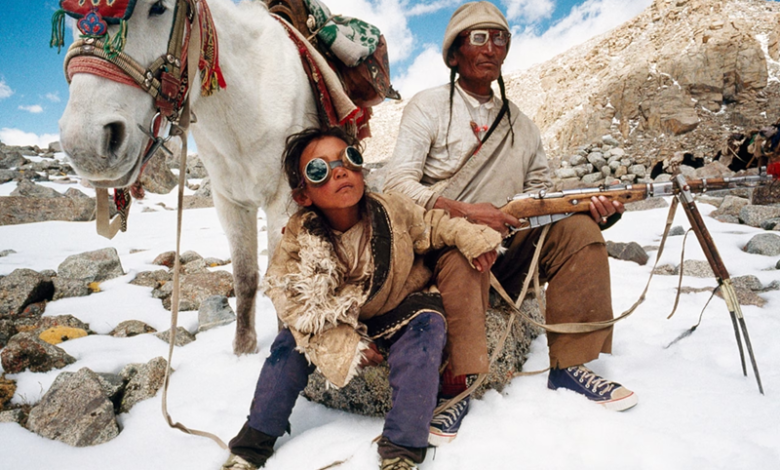How people of Tibet manage to survive with such less oxygen ?

News Mania Desk / Piyal Chatterjee / 23rd October 2024
There was a family that once sat on top of the globe and looked up at the stars. They inhabited what is now Chusang, a location 4200 meters (14,100 feet) above sea level on the Tibetan Plateau. They referred to it as home. This place had its advantages, despite being far from the comforts of more humble climes. A hot spring near the surface served as a pleasant barrier against the chilly air, which is fueled by the tectonic processes that uplift and sustain the plateau. In a hole carved into the slope, the family lighted fires at night, a lone flicker against the zenith of the night.
Even though their fire has long since extinguished, the family’s impact on the globe has endured. 19 handprints and footprints were pushed into the clay-like mud that soaked from the spring as they played and moved, and as they dried, they were preserved into the present. Two of the six people in the family group were children, based on the size of the prints and the hands and feet that created them. However, who were they? And what took them to such great altitudes? Maybe a foraging trip? Hunting? Or were they just inquisitive, constantly looking for unexplored areas?
Such queries remain unanswered by their marks. According to a January 2017 study, the Chusang prints are among the earliest known archeological sites on the Tibetan Plateau, having been created between 12,700 and 7,400 years ago. According to one of the study’s authors, Mark Aldenderfer, an anthropologist from the University of California at Merced, the Chusang family’s uniqueness lies in their seclusion. Since they lived in the middle of the plateau, they were unable to follow the seasons and go up and down the mountain like other Tibetans did at the time. They endured the harsh winds, snowfall, and advancing glaciers of winter here all year long.
It is remarkable that they have survived. Although the warmth of the fire helped keep them warm, the Chusang family was unable to escape the obvious but unavoidable challenge of living on the plateau: the air gets thinner as one moves closer to the sky. Each breath has about one-third less oxygen at elevations above 4,000 meters (13,000 feet) than it does at elevations far lower. However, an ancient and special method of altitude survival that was ingrained in their blood and DNA shielded them from the thin air in which they established their home.
Breathlessness that typically accompanies altitude can be described by any mountain climber. The oxygen content of the air is about 21% everywhere in the world, so it’s not that it’s lower. However, the farther you walk or fly from the sea’s surface, the lower the air pressure becomes, allowing the gas molecules to spread out in all directions. A lung can only expand so far to make up for this.However, there are strategies to cope with this shift in strain. People who live on the Andean altiplano, which stretches from Peru into Bolivia, have developed barrel-shaped chests over many hundreds of generations, which enhance the amount of each breath. Additionally, scientists have known that their blood is pumped fullof red blood cells and haemoglobin, the oxygen-carrying molecules, since the late 1800s.
Because the blood can carry more oxygen to the body’s cells when the air is thin, it thickens. Those who want to trek up a mountain also exhibit this hematopoietic (literally, “blood” and “to make” in Greek) reaction. Cynthia Beall, an anthropologist at Case Western Reserve University in Ohio, adds, “We are fairly similar to Andean highlanders at altitude.” “The general response is the same, but not entirely.”
Furthermore, for almost two centuries, hemopoiesis was thought to be a common reaction to low oxygen levels because almost all studies on high-altitude populations were conducted in the Andes. First of all, they appeared to breathe more quickly than Andeans despite lacking barrel-shaped chests. Second, Beall and her colleagues discovered in the fall of 1981 that Tibetans have unusually low hemoglobin levels, frequently falling within the range of what is typical for sea level residents. Their physiological states appeared very comparable to those of people who had never left the earth’s floor, despite the fact that they reside on the so-called “roof of the world.”
“At first, this was anxiety inducing,” says Beall. “You think, ‘Oh gosh, did I measure the wrong people? Did I do the wrong measurements? Is there something I’m missing?’” But after returning to Tibet and Nepal many times since, collecting more data from more villages, she only found support for her initial results: at high altitude, low-oxygen environments, Tibetan people reduce the amount of oxygen their blood can carry.
How could this be? What at first appears to be highly paradoxical – not to mention potentially dangerous – actually makes a lot of sense, protecting Tibetan people from some of the nastier side effects of the high-life.
One benefit, for instance, is reduced wear and tear on their blood vessels. “If you have high levels of haemoglobin your blood tends to be more viscous, and that can have a lot of damaging effects,” says Tatum Simonson from the University of California in San Diego. “You’re basically pumping this very thick, concentrated blood throughout your system. Your heart is on overdrive.”






